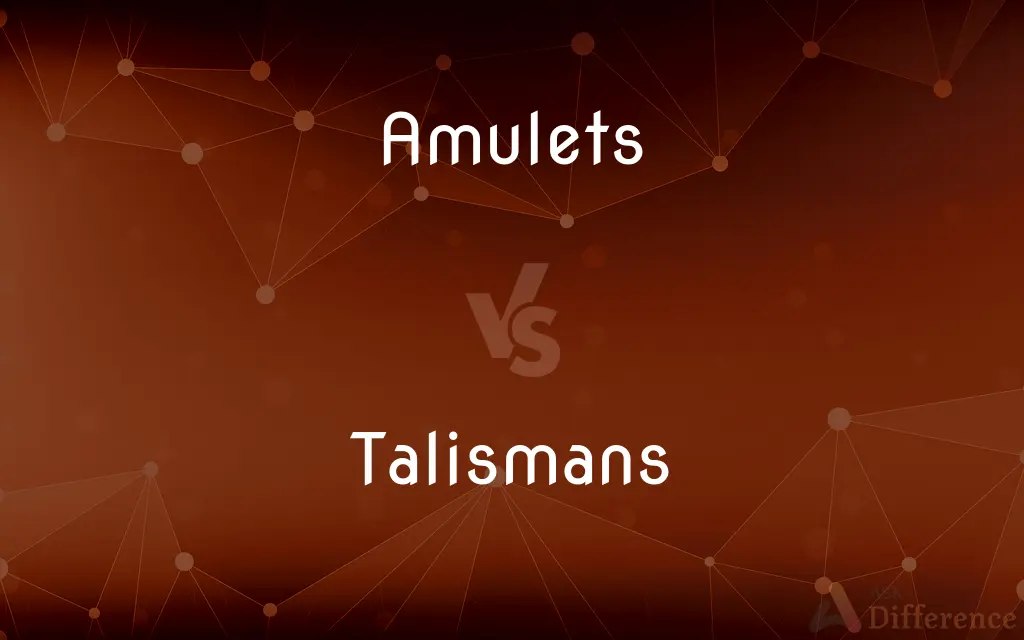Amulets vs. Talismans — What's the Difference?
By Fiza Rafique & Urooj Arif — Published on March 1, 2024
Amulets and talismans are both objects believed to offer protection and bring luck, but amulets primarily ward off negative energies, while talismans are designed to attract specific positive outcomes.

Difference Between Amulets and Talismans
Table of Contents
ADVERTISEMENT
Key Differences
Amulets and talismans are objects imbued with magical or spiritual significance, often used interchangeably but with distinct purposes in various cultural and mystical traditions.
An amulet is typically used for protection, believed to have the power to ward off evil, negativity, or illness. It acts as a shield, absorbing or deflecting harmful influences away from the wearer or bearer. Amulets can be made from various materials, including herbs, stones, and symbols, and are often worn on the body.
Talismans, on the other hand, are created to attract a particular benefit or positive influence, such as good luck, strength, or love. Unlike amulets, which have a more passive protective role, talismans are charged with specific intentions by their creators to draw certain energies or outcomes towards the user. Talismans can also be made from a wide range of materials but are specifically crafted and charged through rituals to serve their intended purpose.
Both amulets and talismans play significant roles in spiritual and magical practices across different cultures, but their primary distinction lies in their intended use, which is protection versus attraction. Understanding this difference helps in choosing the right object for one's personal needs, whether seeking protection from negative forces or desiring to enhance specific aspects of one's life.
Comparison Chart
Purpose
To protect from evil, negativity, or harm
To attract specific positive outcomes or energies
ADVERTISEMENT
Role
Defensive, warding off unwanted influences
Active, drawing in desired qualities or forces
Materials
Made from various materials believed to have protective properties
Crafted from materials chosen for their association with desired outcomes
Usage
Often worn for personal protection
Used to enhance or bring about specific changes
Origins
Found in numerous cultures as protectors
Created with specific intentions and often personalized
Compare with Definitions
Amulets
Protective objects against negative energies.
Wearing an amulet made of black tourmaline for protection against negativity.
Talismans
Created to attract specific qualities or outcomes.
A talisman designed to bring prosperity to its bearer.
Amulets
Often natural or simple symbols.
An amulet in the shape of an eye to ward off the evil eye.
Talismans
Often personalized for the user's desires.
A personalized talisman that symbolizes strength and courage for upcoming challenges.
Amulets
Worn on the body for continuous protection.
She never takes off her amulet for fear of attracting bad luck.
Talismans
Active objects in achieving goals.
Using a talisman to focus her intentions on finding love.
Amulets
Can be any object believed to offer protection.
A cherished ring passed down through generations serves as her amulet.
Talismans
Requires specific crafting and charging rituals.
The talisman was charged with positive affirmations during its creation.
Amulets
Absorbs or deflects harmful influences.
This amulet is believed to absorb negative energies from its surroundings.
Talismans
Charged with intentional energy.
He crafted a talisman under the full moon to capture its energy for inspiration.
Amulets
Plural of amulet
Talismans
An object marked with magic signs and believed to confer on its bearer supernatural powers or protection.
Talismans
Something that apparently has magic power.
Talismans
Plural of talisman
Common Curiosities
How do you activate an amulet or talisman?
Activation involves rituals or intentions specific to the object's purpose, such as prayer, charging under moonlight, or anointing with oils.
Is belief necessary for amulets and talismans to work?
While belief can enhance the user's connection to the object, many traditions hold that the object's power is inherent.
Are there digital amulets or talismans?
In contemporary practices, digital symbols or images are sometimes used with the same intentions, adapting ancient practices to modern life.
How often should amulets and talismans be cleansed?
Regular cleansing is recommended to clear absorbed or stagnant energies, especially after heavy or intense use.
Can anyone create a talisman?
Yes, with the right intentions and understanding of the symbolic materials and charging rituals, anyone can craft a talisman.
Can amulets and talismans lose their power?
Over time or if not properly maintained, they may need to be recharged or replaced to ensure their protective or attractive qualities remain strong.
Can an object be both an amulet and a talisman?
Yes, an object can serve both protective and attractive functions if it's programmed with both intentions.
Do amulets and talismans need to be worn to work?
While many are worn for continuous influence, others can be carried or placed in relevant areas, depending on their purpose.
How do you choose the right amulet or talisman?
Selection is based on the desired outcome, personal resonance with the object, and sometimes astrological or spiritual guidance.
What's the difference in maintenance between amulets and talismans?
Both require respect, belief in their power, occasional cleansing, and recharging to maintain their efficacy.
Share Your Discovery

Previous Comparison
Brandy vs. Whisky
Next Comparison
Power of Attorney vs. ConservatorshipAuthor Spotlight
Written by
Fiza RafiqueFiza Rafique is a skilled content writer at AskDifference.com, where she meticulously refines and enhances written pieces. Drawing from her vast editorial expertise, Fiza ensures clarity, accuracy, and precision in every article. Passionate about language, she continually seeks to elevate the quality of content for readers worldwide.
Co-written by
Urooj ArifUrooj is a skilled content writer at Ask Difference, known for her exceptional ability to simplify complex topics into engaging and informative content. With a passion for research and a flair for clear, concise writing, she consistently delivers articles that resonate with our diverse audience.
















































